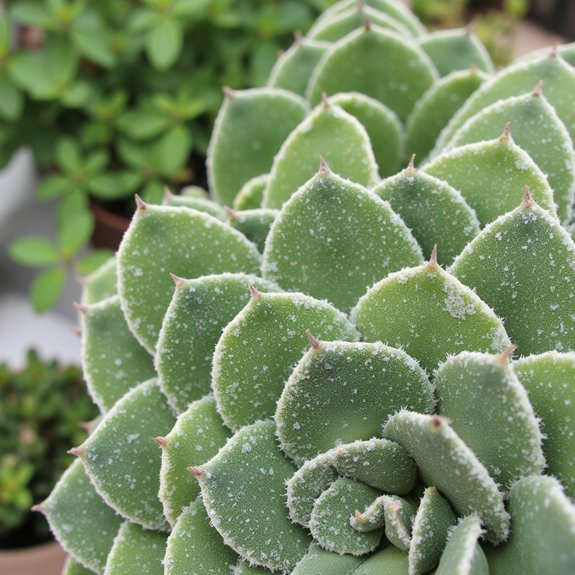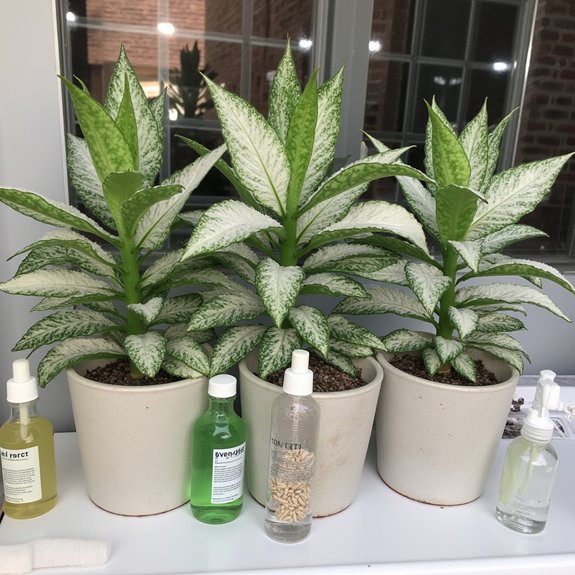Powdery mildew transforms healthy succulents into white, dusty casualties faster than most gardeners realize. This persistent fungal enemy thrives in the exact conditions many indoor succulent collections accidentally provide, spreading silently through spores that travel on air currents, clothing, and gardening tools. The telltale white patches often appear overnight, particularly on stressed plants or those crowded together without proper ventilation. What makes this fungus particularly troublesome is its ability to weaken plants systematically, but understanding its behavior reveals surprisingly simple countermeasures.
Contents
- 1 What Is Powdery Mildew and Why Does It Target Succulents
- 2 Environmental Conditions That Encourage Powdery Mildew Growth
- 3 Recognizing Early Signs of Powdery Mildew on Succulent Plants
- 4 Immediate Steps to Take When You Discover an Infected Plant
- 5 Effective Treatment Methods for Different Severity Levels
- 6 Natural and Chemical Solutions That Actually Work
- 7 Prevention Strategies to Keep Your Collection Healthy
What Is Powdery Mildew and Why Does It Target Succulents

Powdery mildew presents itself as a fungal menace that can infiltrate even the most carefully maintained succulent collections. This disease stems from Ascomycota fungi, a vast phylum containing over 60,000 species with diverse fungal characteristics ranging from beneficial baker’s yeast to destructive plant pathogens.
While succulents aren’t primary targets like cucumbers or roses, their plant susceptibility increases under specific conditions. High humidity combined with poor airflow creates ideal environments for spore development around 75°F. The fungi spread through wind-carried spores, contaminated soil, or nearby infected plants, making even isolated succulent collections vulnerable to this persistent threat.
Environmental Conditions That Encourage Powdery Mildew Growth
Understanding the specific environmental triggers helps succulent enthusiasts prevent fungal outbreaks before they begin. Powdery mildew thrives when humidity levels climb above 60%, particularly in temperatures around 75°F. Unlike other fungal diseases, it spreads without requiring wet foliage, making dry conditions with high ambient moisture ideal for growth.
Poor airflow management creates perfect breeding grounds, as stagnant air traps moisture around plants. Overcrowded collections, indoor spaces with limited ventilation, and areas with inconsistent air circulation become hotspots for infection. Maintaining proper spacing between plants and ensuring adequate ventilation greatly reduces risk factors for this persistent fungal problem.
Recognizing Early Signs of Powdery Mildew on Succulent Plants

How can gardeners spot powdery mildew before it devastates their entire succulent collection? Early symptoms often appear subtly, making detection challenging on thick succulent leaves.
The telltale dusty white powder becomes less obvious on waxy surfaces, requiring closer inspection. Instead, watch for unusual leaf discoloration patterns developing gradually over days.
Brown or rust-colored scab-like lesions signal infection, sometimes surrounded by gray or white rings. Kalanchoe and Echeveria species show these signs most clearly.
Unfortunately, these symptoms resemble sunscald damage, complicating identification. Check multiple leaves carefully, focusing on areas with poor airflow where spores typically establish first.
Immediate Steps to Take When You Discover an Infected Plant
Act swiftly upon discovering the first signs of infection, as immediate isolation prevents the fungal spores from spreading to nearby plants. Move the affected succulent at least three feet away from healthy specimens, using clean gloves to avoid contamination.
Effective isolation techniques include placing infected plants in a separate room or designated quarantine area with good airflow. Avoid drastic temperature changes during relocation, as stressed plants become more susceptible to further damage.
Immediate action requires evaluating the infection’s severity before choosing treatment methods. Document affected areas with photos to track recovery progress over the coming weeks.
Effective Treatment Methods for Different Severity Levels

Once the infected plant sits safely in quarantine, gardeners must match their treatment approach to the infection’s severity level. Minor infections affecting just a few leaves respond well to neem oil applications, which serve as both treatment and prevention. For moderate infection levels, copper fungicide provides stronger control while remaining gentle on succulent tissues. Severe cases require sulfur treatments with complete leaf coverage, applied every couple days until recovery appears. Treatment severity should escalate gradually, starting with the mildest option first. Always test treatments on small plant sections before full application to avoid additional damage.
Natural and Chemical Solutions That Actually Work
Gardeners facing powdery mildew can choose from several proven solutions that range from gentle household remedies to targeted commercial fungicides. Natural remedies include neem oil, which works effectively for minor infections when diluted according to package instructions. Always test on a small leaf section first to check for adverse reactions.
Chemical treatments offer stronger intervention for severe cases. Copper fungicides provide broad-spectrum control, while sulfur requires complete leaf coverage every couple of days until recovery appears. Low-concentration formulas work best for succulents’ sensitive nature, preventing plant shock while eliminating fungal growth.
Prevention Strategies to Keep Your Collection Healthy
While treatment options can rescue infected plants, preventing powdery mildew from taking hold in the first place saves both time and stress for succulent enthusiasts. Proper plant spacing creates vital barriers between specimens, reducing spore transmission risks. Position succulents at least 3-4 inches apart to maintain adequate distance.
Effective airflow management proves essential for prevention. Place collections near gentle air circulation sources, avoiding stagnant conditions that encourage fungal growth. Indoor growers benefit from small fans positioned 4-6 feet away.
Regular preventative spraying helps vulnerable varieties like Kalanchoe and Echeveria. Apply diluted neem oil treatments monthly during humid seasons, maintaining consistent care routines that support overall plant health and resistance.
